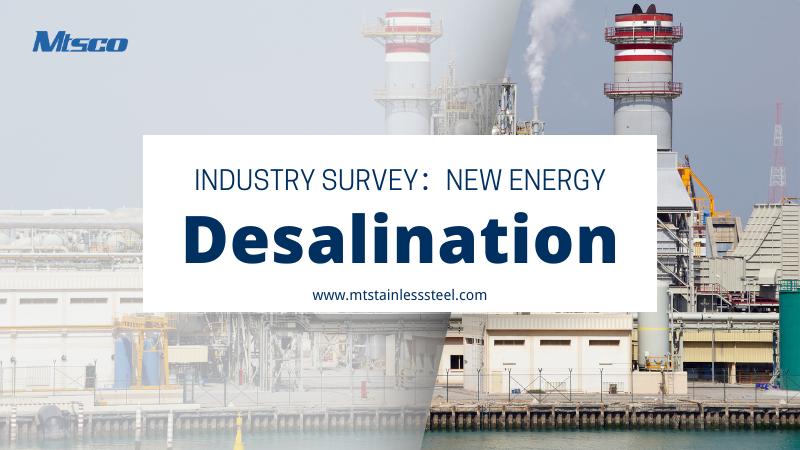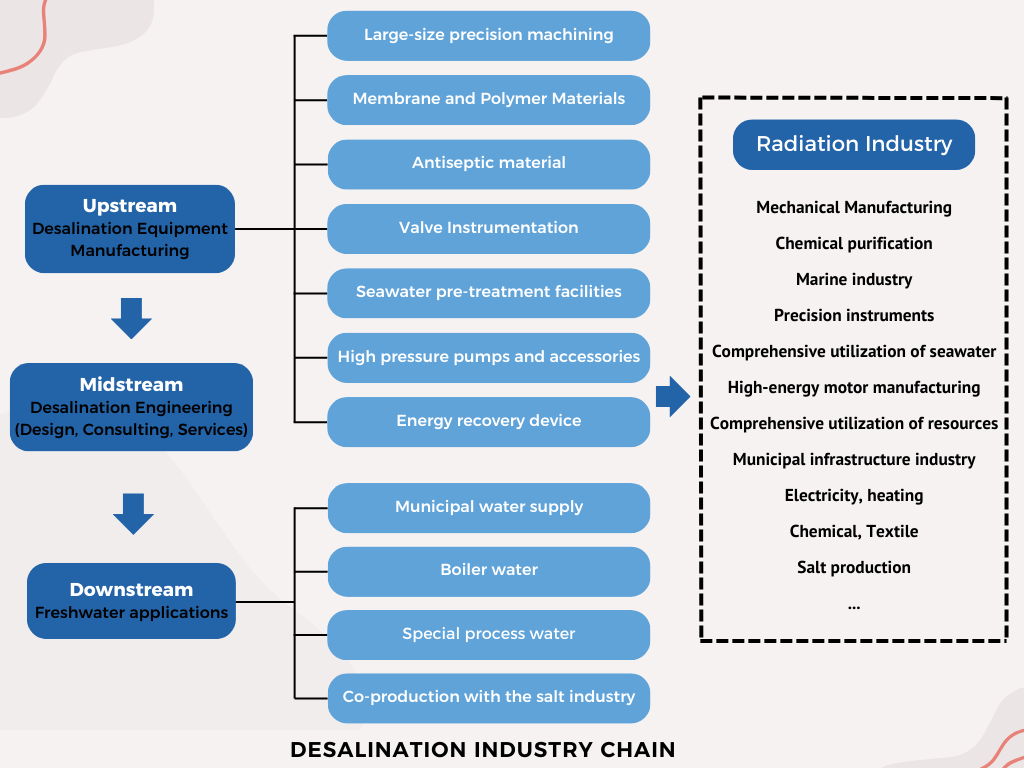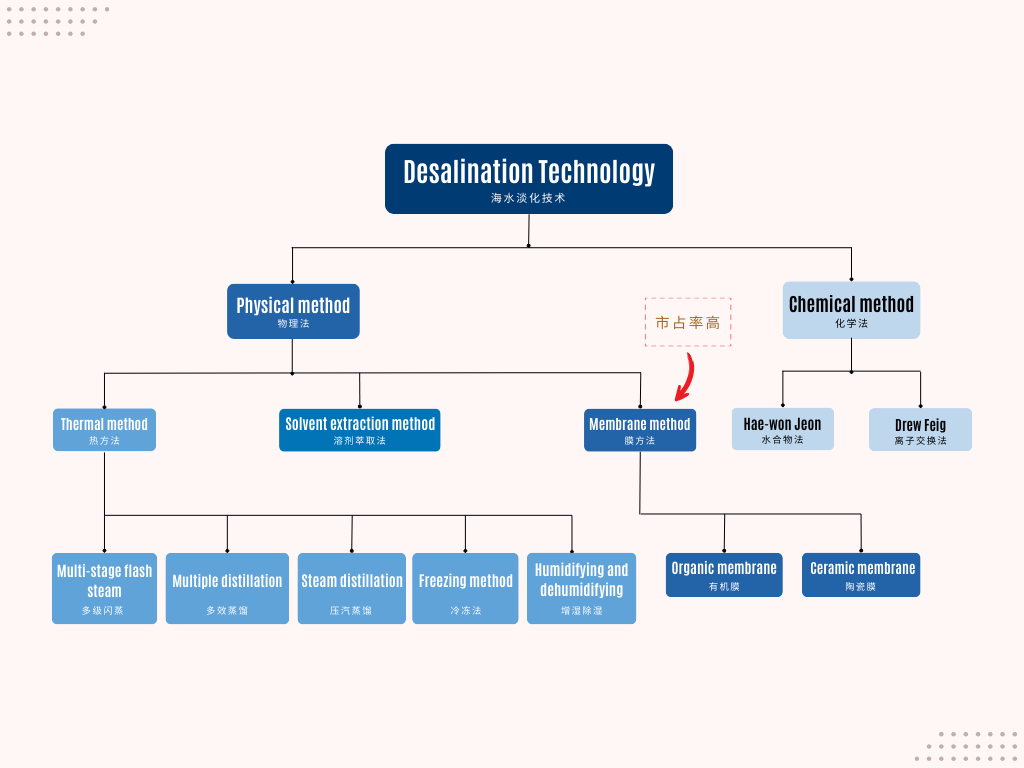New Energy - Desalination

Overview
Global demand for freshwater has risen sharply as a result of population growth and urbanization, but only 2.5 per cent of freshwater resources are available. Global water scarcity has become a major challenge. Desalination is a method of removing salts and impurities from seawater and converting it into usable fresh water through technological means. This article provides an overview of the industry by exploring desalination overview, challenges, industry chain, technology and equipment.
Industry Chain
Upstream equipment suppliers provide high-quality hardware and components, including reverse osmosis membrane systems, multi-stage flash distillation units, precision machining, anti-corrosion materials and energy recovery units. Midstream engineering companies are responsible for project design, consulting and implementation, including civil engineering, equipment installation and commissioning. The downstream application areas are mainly used for municipal water supply, industrial water and agricultural irrigation, verifying the practical benefits of seawater desalination technology.

Desalination Technology
Desalination technologies are mainly divided into physical and chemical methods. Physical methods include thermal, extraction and membrane methods, while chemical methods include hydrate and ion exchange methods. Currently, the most dominant desalination processes are multistage flash evaporation (MSF) and reverse osmosis (RO).
Among them, reverse osmosis membrane systems and multistage flash distillation units are the two most widely used.

Industry and Product Match
Various segments of the desalination industry have specific needs for materials and equipment, and MTSCO has contributed to the development and progress of the industry by providing highly corrosion-resistant and high-strength products that meet the stringent requirements of the desalination industry. MTSCO's products are a remarkable match for seawater transfer, evaporators, reverse osmosis units, desalination pumps, and multi-stage flash evaporation processes, to name just a few.
Seawater transportation: As the first part of the desalination process, corrosion-resistant and high strength piping products, such as 316L or 2507 duplex steel piping, are in high demand.
Evaporator: as one of the key components of seawater desalination, it usually adopts materials with excellent corrosion resistance, such as 254SMO, 2205 and 2507 duplex steel pipes, plates and fittings, which are in high demand.
Reverse osmosis unit: The reverse osmosis unit in the reverse osmosis process requires high corrosion resistance and high strength materials, such as pipes, plates, fittings and flanges of 254SMO and 2507 duplex steel, which are in high demand.
Desalination pumps: play a key role in the desalination process and require high corrosion resistant materials, such as 2507 duplex steel pipes, with high demand.
Prefabricated parts and equipment manufacturing in the core area of the equipment: high corrosion-resistant grade materials, such as 6MO 31254 steel, with relatively low demand for dual-phase steel.

Conclusion
The global desalination market has a broad prospect. With technological advances and growing demand, desalination will become an important water resource solution in the future, and MTSCO will play an important role in the development of the industry with its high-performance products, contributing to the sustainable development of society and economy.
Cited sources
1. Emirates National Desalination Company. (2023). Jebel Ali Desalination Plant Overview.
2. Environmental Protection Agency. (2022). Impact of Desalination on Marine Environment. Washington, DC: EPA.
3. Global Desalination Market Report. (2023). Comprehensive Analysis of the Desalination Industry. London: Water Market Research.
4. Global Market Research Company. (2022). Desalination Industry Trends and Projections.
5. Global Water Intelligence. (2022). Desalination Plants and Projects Database. Oxford: GWI.
6. Global Water Resources Management Report. (2022). Industrial and Agricultural Use of Desalinated Water.
7. Global Water Treatment Equipment Market Report. (2023). Analysis of Desalination Equipment Suppliers.
8. Industrial Water Treatment Journal. (2023). Application of Desalinated Water in Industry.
9. International Desalination Association. (2022). State of the Industry Report. London: IDA.
10. International Desalination Association. (2022). Market Overview and Forecast. London: IDA.
11. International Resource Management Institute. (2023). Future Trends in Desalination.
12. International Water Management Institute. (2022). Advances in Desalination Technology. Colombo: IWMI.
13. Municipal Water Annual Review. (2023). Urban Water Supply through Desalination. New York: Municipal Water Association.
14. Saudi Desalination Research Center. (2022). Annual Report on Water Production. Riyadh: SDRC.
15. United Nations. (2021). World Water Development Report 2021. New York: United Nations.
16. Wikipedia. (2022). Seawater Desalination. Retrieved from https://en.wikipedia.org/wiki/Seawater_desalination.
17. World Bank. (2023). Financing Desalination Projects in Developing Countries. Washington, DC: World Bank.
18. World Desalination Association. (2023). Global Desalination Market Analysis. London: WDA.
19. Agricultural Science Journal. (2023). Use of Desalinated Water in Irrigation.
20. Desalination Technology Research Institute. (2023). Seawater Desalination Challenges.
21. Engineering Technology Magazine. (2023). Desalination Project Planning and Implementation.
22. International Engineering Consulting Company Report. (2023). Technical Consulting for Desalination Projects.
